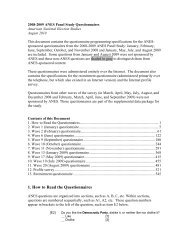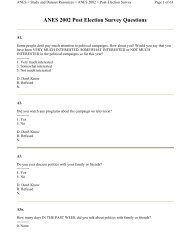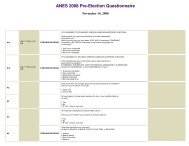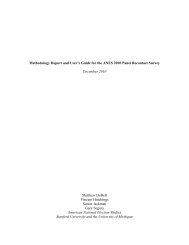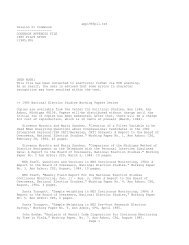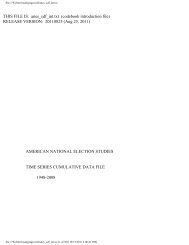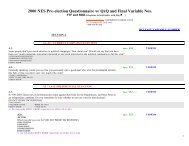How to Analyze ANES Survey Data - American National Election ...
How to Analyze ANES Survey Data - American National Election ...
How to Analyze ANES Survey Data - American National Election ...
Create successful ePaper yourself
Turn your PDF publications into a flip-book with our unique Google optimized e-Paper software.
Table 1. Estimated percentages, standard errors, and root design effects from the 2006 <strong>ANES</strong> Pilot Study, calculated by alternative methods—continued<br />
Design-consistent, with Design-consistent, with<br />
SRS, unweighted SRS, weighted Adjusted weight<br />
published strata<br />
modified strata<br />
Characteristic Percent s.e. Percent s.e. Percent s.e. DEFT Percent s.e. DEFT Percent s.e. DEFT<br />
Trust in government (v06p656)<br />
Always 0.9 0.61 0.7 0.55 0.7 0.74 1.35 0.7 — — 0.7 0.54 0.98<br />
Most of the time 18.2 2.54 15.3 2.37 15.3 3.20 1.35 15.3 — — 15.3 2.91 1.23<br />
About half the time 49.4 3.30 54.9 3.27 54.9 4.42 1.35 54.9 — — 54.9 4.79 1.46<br />
Once in a while 27.3 2.94 24.9 2.85 24.9 3.84 1.35 24.9 — — 24.9 3.27 1.15<br />
Never 4.3 1.34 4.1 1.30 4.1 1.76 1.35 4.1 — — 4.1 1.44 1.10<br />
Internal efficacy (v06p653)<br />
A great deal 8.4 1.53 8.2 1.51 8.2 2.03 1.35 8.2 — — 8.2 2.27 1.51<br />
A lot 13.6 1.88 13.1 1.85 13.1 2.50 1.35 13.1 — — 13.1 1.62 0.87<br />
A moderate amount 33.1 2.59 31.5 2.55 31.5 3.44 1.35 31.5 — — 31.5 3.53 1.38<br />
A little 35.8 2.64 34.9 2.62 34.9 3.53 1.35 34.9 — — 34.9 4.33 1.66<br />
Not at all 9.0 1.58 12.3 1.80 12.3 2.43 1.35 12.3 — — 12.3 2.91 1.61<br />
Interest in politics (v06p630)<br />
Extremely interested 18.2 2.10 15.8 1.98 15.8 2.67 1.35 15.8 — — 15.8 2.05 1.04<br />
Very interested 39.4 2.65 38.6 2.64 38.6 3.56 1.35 38.6 — — 38.6 5.44 2.06<br />
Moderately interested 33.2 2.56 34.5 2.58 34.5 3.48 1.35 34.5 — — 34.5 4.67 1.81<br />
Slightly interested 8.5 1.52 10.1 1.63 10.1 2.20 1.35 10.1 — — 10.1 2.35 1.44<br />
Not interested at all 0.3 0.29 0.9 0.51 0.9 0.69 1.35 0.9 — — 0.9 0.92 1.80<br />
Refused 0.3 0.29 0.2 0.24 0.2 0.33 1.35 0.2 — — 0.2 0.21 0.87<br />
Interpersonal trust (v06p519)<br />
Always 1.5 0.66 1.3 0.62 1.3 0.83 1.35 1.3 0.55 0.89 1.3 0.55 0.89<br />
Most of the time 46.9 2.71 41.7 2.68 41.7 3.61 1.35 41.7 4.26 1.59 41.7 4.31 1.61<br />
About half the time 31.6 2.53 34.9 2.59 34.9 3.49 1.35 34.9 4.06 1.57 34.9 4.05 1.56<br />
Once in a while 18.0 2.09 19.1 2.13 19.1 2.88 1.35 19.1 3.09 1.45 19.1 3.01 1.41<br />
Never 1.8 0.72 2.9 0.91 2.9 1.23 1.35 2.9 1.70 1.87 2.9 1.72 1.89<br />
Refused 0.3 0.29 0.1 0.17 0.1 0.23 1.35 0.1 0.10 0.58 0.1 0.10 0.58<br />
Importance of religion (v06p552)<br />
Important 73.9 1.69 73.8 1.69 73.8 2.28 1.35 73.8 2.69 1.59 73.8 2.72 1.61<br />
Not important 25.9 1.69 26.1 1.69 26.1 2.28 1.35 26.1 2.69 1.59 26.1 2.71 1.60<br />
Refused 0.1 0.15 0.1 0.12 0.1 0.16 1.35 0.1 0.09 0.74 0.1 0.09 0.74<br />
Notes: — Statistic cannot be calculated by standard techniques.<br />
"SRS, unweighted" estimates are calculated assuming simple random sampling, without weights. This method is not recommended.<br />
"SRS, weighted" estimates are calculated assuming simple random sampling, weighted by v06p002. This method of calculating standard<br />
"Adjusted weight" estimates are calculated with v06p002 adjusted by the average design effect (v06p002/1.82), reducing the effective<br />
"Design consistent, with published strata" estimates are weighted by v06p002 and use Taylor series standard errors based on stratum and<br />
"Design consistent, with modified strata" estimates are weighted by v06p002 and use Taylor series standard errors based on collapsed<br />
s.e. is standard error, also known as sampling error.<br />
DEFT is the square root of the design effect (DEFF). Each DEFT equals the s.e. in the adjacent column divided by the s.e. in the "SRS,<br />
Source: 2004 <strong>National</strong> <strong>Election</strong> Study and 2006 <strong>ANES</strong> Pilot Study (datasets).<br />
Example of Regression Analysis<br />
Table 2 presents logistic regression analyses with the 2008 <strong>ANES</strong> Time Series data, calculated three<br />
different ways <strong>to</strong> illustrate the differences between the selected methods.<br />
In each case the same model is presented. The purpose of the model is only <strong>to</strong> illustrate an analysis, so<br />
the choice of variables was arbitrary. The dependent variable is voting for Barack Obama in the 2008<br />
general election. It is coded 1 if the respondent voted for Obama and 0 if the respondent voted for<br />
another candidate. Nonvoters were excluded from the analysis. The independent variables are party ID,<br />
feeling thermometers for Obama and McCain, the respondent’s sex and educational attainment, whether<br />
the respondent is black, belief about the Bible being the word of God, whether the Iraq war was worth<br />
the cost, whether homosexuals should be allowed <strong>to</strong> serve in the armed forces, and the interviewer’s<br />
assessment of whether the respondent seemed well informed. Each independent variable was re-scaled<br />
<strong>to</strong> range from 0 <strong>to</strong> 1. Exhibit 2 shows the Stata code for the analyses.<br />
26



